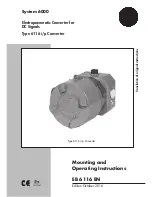
Page 42 Non-Sound Decoder MX618 - MX634 and Sound Decoder MX640 - MX648
CV
Designation
Range
De-
fault
Description
#532
Function sound F7
0 - 255
0
Volume for function sound F7
#535
Function sound F8
0 - 255
0
Volume for function sound F8
#538
Function sound F9
0 - 255
0
Volume for function sound F9
#541
Function sound F10
0 - 255
0
Volume for function sound F10
#544
Function sound F11
0 - 255
0
Volume for function sound F11
#547
Function sound F12
0 - 255
0
Volume for function sound F12
#550
Function sound F13
0 - 255
0
Volume for function sound F13
#553
Function sound F14
0 - 255
0
Volume for function sound F14
#556
Function sound F15
0 - 255
0
Volume for function sound F15
#559
Functions-Sound F16
0 - 255
0
Volume for function sound F16
#562
Function sound F17
0 - 255
0
Volume for function sound F17
#565
Function sound F18
0 - 255
0
Volume for function sound F18
#568
Function sound F19
0 - 255
0
Volume for function sound F19
#674, #677…#698 = volume for sounds on F20, F21…F28.
Note:
The CV’s between the above (#570, 572, #513, 515, 516, 518 etc.) hold information for the relevant sound
samples (sample numbers, loop parameters etc.), which can also be modified if needed, usually with the CV #300
procedures.
Switch input sounds - Volume adjustments:
#739
Switch input sound S1
0 - 255
=
100, 1-100 %
0
Volume setting for the sound activated by switch input S1.
= 0: full volume, original sample volume (same as 255)
= 1 .. 254: reduced volume 1 - 99,5 %
= 255: full volume
#741
Switch input sound S2
0 - 255
0
Volume setting for the sound activated with switch input S2
#743
Switch input sound S3
0 - 255
0
Volume setting for the sound activated with switch input S3
Note:
The CV immediately ahead of the CV’s listed
(# 740, 742)
contains the sound sample numbers to be played.
Random sounds - Volume adjustments
:
#745
Random sound Z1
Volume setting for sound activated by random generator Z1
#748
Random sound Z2
Volume setting for sound activated by random generator Z2
#751
Random sound Z3
Volume setting for sound activated by random generator Z3
#754
Random sound Z4
Volume setting for sound activated by random generator Z4
#757
Random sound Z5
Volume setting for sound activated by random generator Z5
#760
Random sound Z6
Volume setting for sound activated by random generator Z6
#763
Random sound Z7
Volume setting for sound activated by random generator Z7
#766
Random sound Z8
Volume setting for sound activated by random generator Z8
Note
: The CV immediately ahead of the CV’s listed
(#744, 747 etc.)
contain the sound sample numbers to be played.
5.5 Steam engine
Basic sound settings
The following CV’s can be programmed both
“normal”
(i.e. CV #... = ...) and
“incremental”.
“In-
cremental programmi
ng” is especially useful when the proper value cannot be calculated in advance
and must be determined by trial, which is often the case with many sound parameters.
The “Lead CV” in each case is the first of a group of 3 CV’s, which are edited and displayed together
on a ZIMO MX31/MX32 cab during the “incremental programming” procedure.
CV
Designation
Range
INC-
step
De-
fault
Description
LEAD
- CV
#266
Total volume
0 - 255
5
64
See chapter
5.4 “Basic settings independent of powertrain”
#267
Chuff sound
frequency with
“virtual cam sensor“
also see CV #354 in
this table
(chuff frequency at
speed step 1)
0 - 255
1
70
CV #267 is only active if
CV #268 = 0:
Chuff beats follow the “virtual cam sensor”; an ac-
tual cam sensor is not needed in this case.
The default setting “70” results in about 4, 6 or 8
chuffs per wheel revolution, depending on the
chuff set selected; because it also depends in
large part on the motor and gearbox used, an in-
dividual adjustment is necessary in most cases in
order to achieve the exact chuff frequency. This is
the purpose for CV #267:
The lower the value the higher the chuff frequency
and vice versa. The setting should be performed
at a low speed (around speed step 10), but not at
the lowest speed step 1.
#268
Switching to real
cam sensor
and
trigger count for chuff
rate
and
Special function for
“Simple articulated”
steam engines
0
– 63
and
Bits 6 & 7
1
0
= 0
: “Virtual“ cam sensor is active (to be adjusted
with CV #267, see above).
= 1: real cam sensor is active (connected to
switch input 2 of the MX640, see chapter 6);
each negative spike results in a chuff beat.
= 2, 3, 4 … real cam sensor, several triggers in
sequence
(2, 3, 4 …) result in one chuff beat.
= 128 (Bit 7=1 with “virtual” cam sensor): second
driver is a bit slower; only meaningful if a
second sound sample is available in the
sound project.
= 192 (Bit 6 and 7 = 1): When no separate sound
sample is available for the second driver, the
same sample is played back for the second
driver albeit a bit slower.
















































